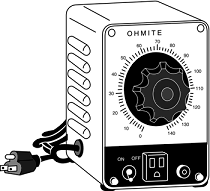Specialized Power Supply Test Equipment
You can use several types of specialized test gear to test power supplies more effectively. Because the power supply is one of the most failure-prone items in PCs today, you should have these specialized items if you service many PC systems. One of the greatest additions to your toolbox is a digital infrared thermometer.
They also are called noncontact thermometers because they measure by sensing infrared energy without having to touch the item they are reading. This enables me to make instant spot checks of the temperature of a chip, a board, or the system chassis. They are available from companies such as Raytek for under $100.
To use these handheld items, you point at an object and then pull the trigger. Within seconds, the display shows a temperature readout accurate to +/–3°F (2°C). These devices are invaluable in checking to ensure the components in your system are adequately cooled.
Variable Voltage Transformer
When testing power supplies, it is sometimes desirable to simulate different AC voltage conditions at the wall socket to observe how the supply reacts. A variable voltage transformer is a useful test device for checking power supplies because it enables you to exercise control over the AC line voltage used as input for the power supply.

This device consists of a large transformer mounted in a housing with a dial indicator that controls the output voltage. You plug the line cord from the transformer into the wall socket and plug the PC power cord into the socket provided on the transformer. The knob on the transformer can be used to adjust the AC line voltage the PC receives.
Most variable transformers can adjust their AC outputs from 0V to 140V no matter what the AC input (wall socket) voltage is. Some can cover a range from 0V to 280V, as well. You can use the transformer to simulate brownout conditions, enabling you to observe the PC's response.
Thus, you can check a power supply for proper Power_Good signal operation, among other things. By running the PC and dropping the voltage until the PC shuts down, you can see how much reserve is in the power supply for handling a brownout or other voltage fluctuations.
If your transformer can output voltages in the 200V range, you can test the capability of the power supply to run on foreign voltage levels. A properly functioning supply should operate between 90V and 135V but should shut down cleanly if the voltage is outside that range.
One indication of a problem is seeing parity check-type error messages when you drop the voltage to 80V. This indicates that the Power_Good signal is not being withdrawn before the power supply output to the PC fails.
The PC should simply stop operating as the Power_Good signal is withdrawn, causing the system to enter a continuous reset loop. Variable voltage transformers are sold by a number of electronic parts supply houses, such as Newark and Digi-Key. You should expect to pay anywhere from $100 to $300 for this device.